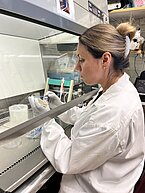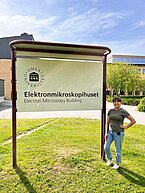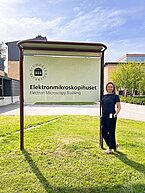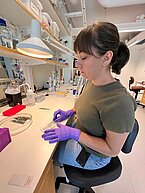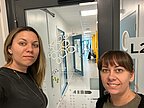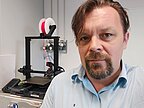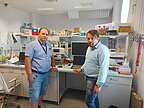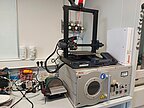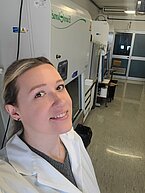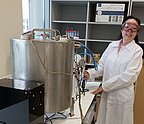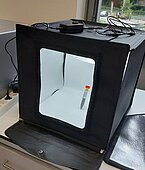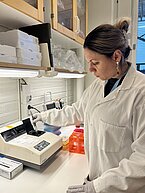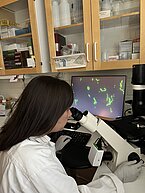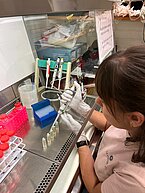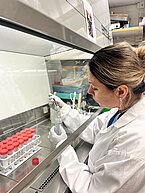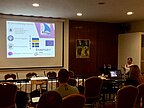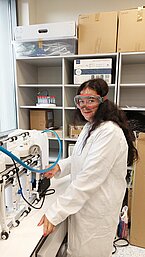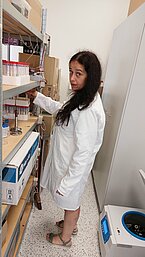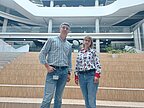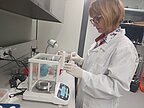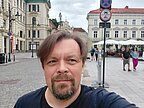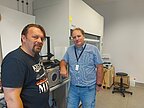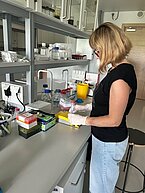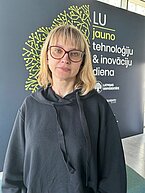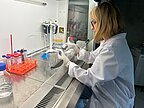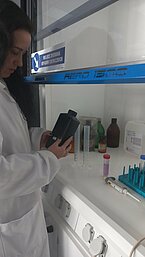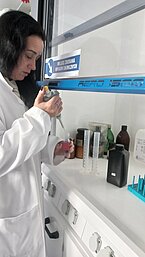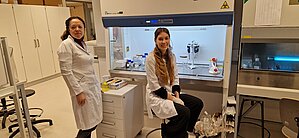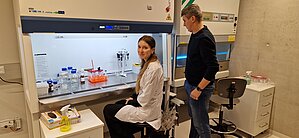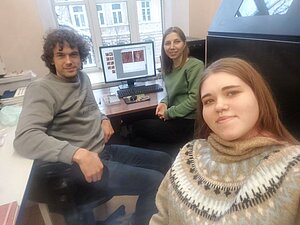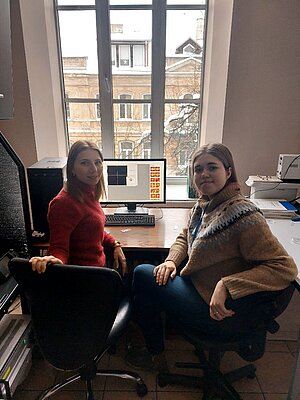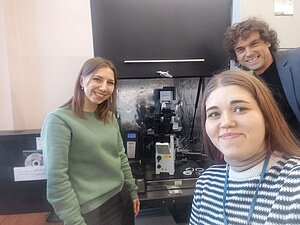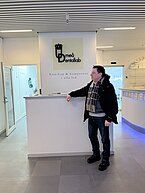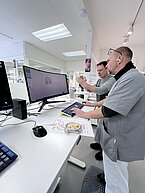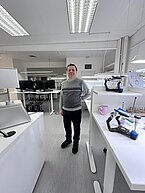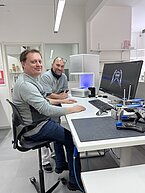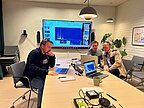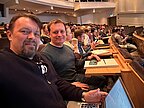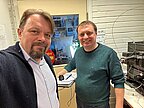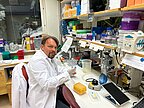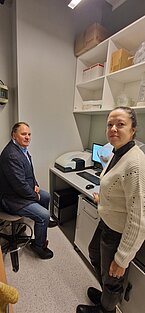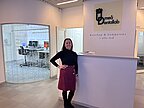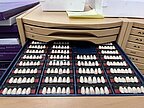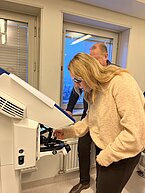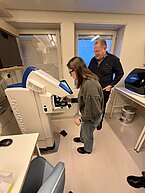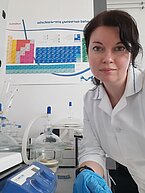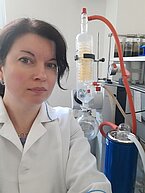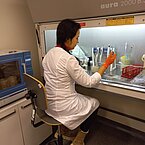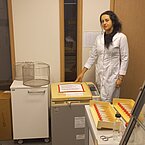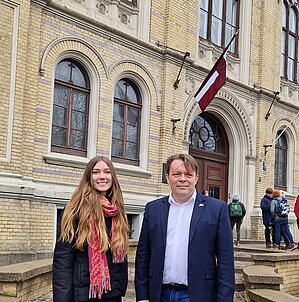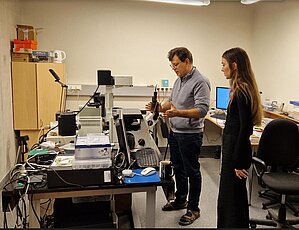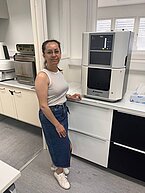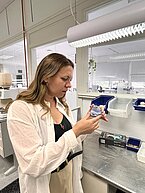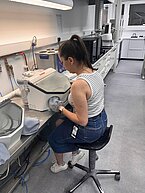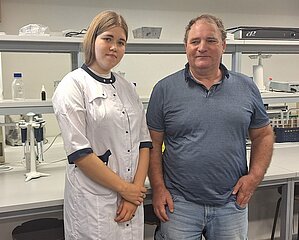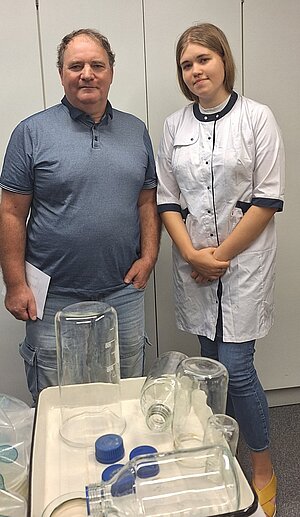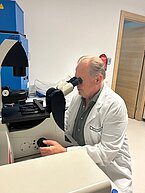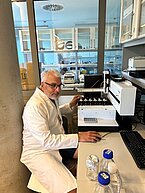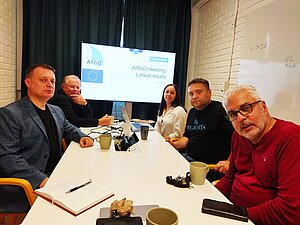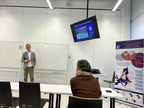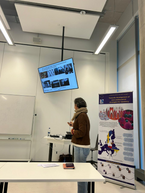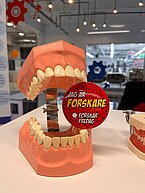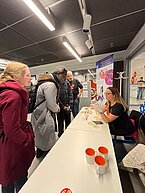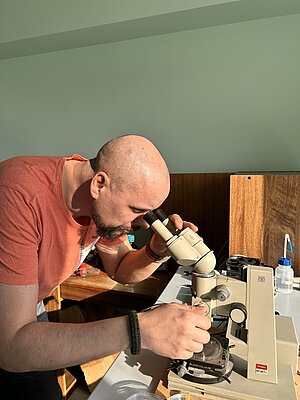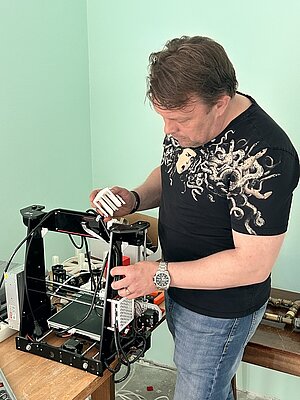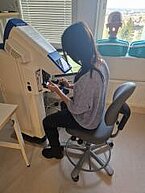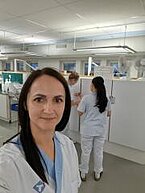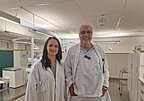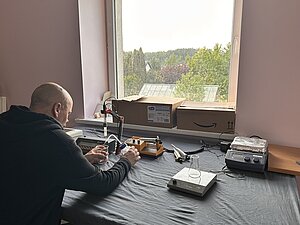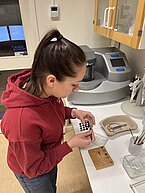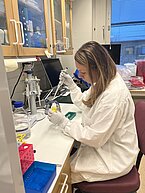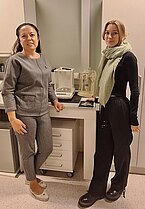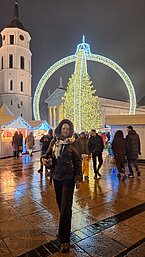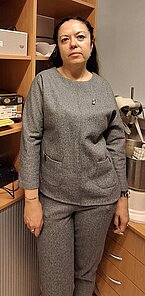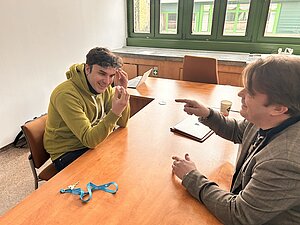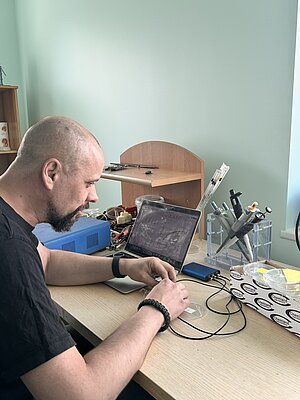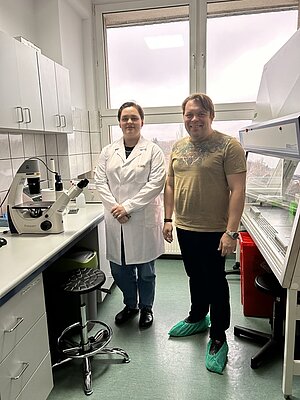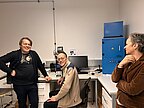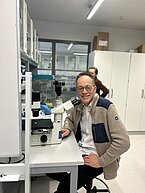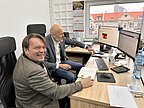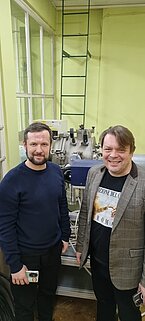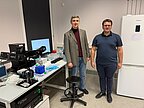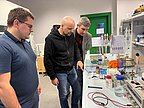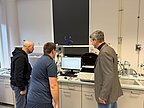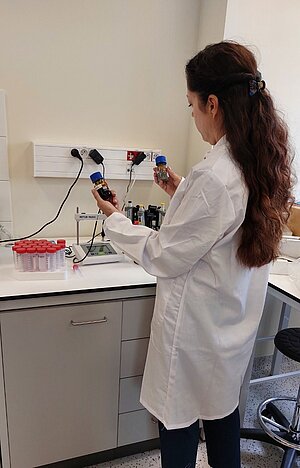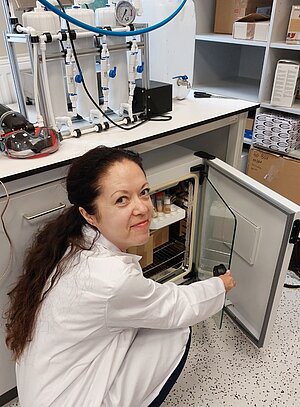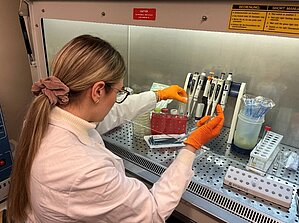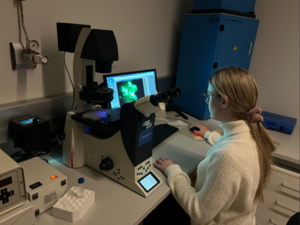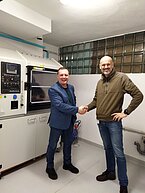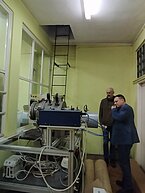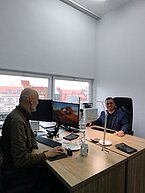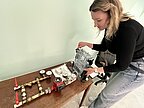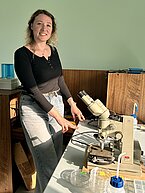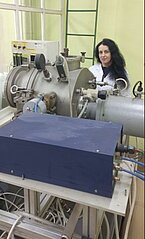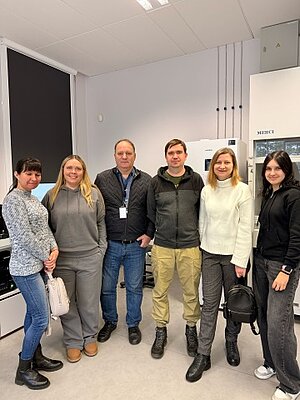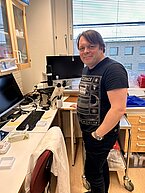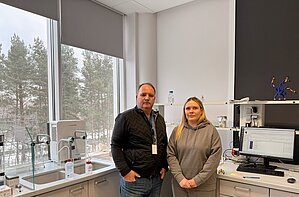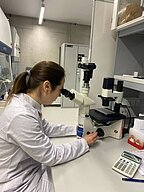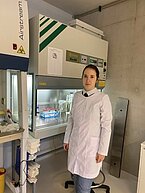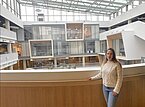From 12 May till 11 July, Anna Butsyk and Iryna Tkachenko had a secondment to the Umeå University, Umeå, Sweden.
During the secondment period Anna and Iryna tested the antibacterial action of silver nanoparticles, denoted AgNPs to Gram-positive and Gram-negative bacteria. Anna focused on developing the dental model and was also responsible for the model validation experiments, while Iryna focused on studies of the physical properties of the AgNPs by electron microscopy (EM) at the Umeå Centre for Electron microscopy (UCEM) facility.
From 24 May till 23 June, Dr. Maksym Pogorielov had a secondment to the "MB Sensografa" in Vilnius, Lithuania.
During the visit, we conducted a comprehensive characterisation of Ag nanoparticles and ZnO/ZnO-Au nanocomposites using SEM, TEM, FTIR, and Raman techniques. All the obtained data has been archived for future analysis and preparation of research papers. A research seminar on the application of hydroxyapatite in dentistry and surgery was delivered. The nanoparticles and nanocomposites were selected for in-vitro investigation.
From 20 July till 19 August 2023, Dr. Viktoriia Korniienko and Ph.D. student Kateryna Diedkova visited (Nanowave) Warszawa, Poland.
During the visit, training sessions focusing on laboratory and chemical safety were conducted. We then proceeded to synthesize silver (Ag) and copper (Cu) nanoparticles, which are potentially useful for biomedical applications. The obtained data provided valuable insights into the properties of the nanoparticles produced. We engaged in the preparation and discussion of a draft research publication.
Overall, the visit was a valuable opportunity to expand our knowledge and skills in the field of nanomaterials synthesis and characterization. It also allowed us to contribute to ongoing research projects aimed at developing innovative strategies to combat antibiotic resistance and improve dental healthcare.
From 22 July till 21 September, Anna Butsyk and Iryna Tkachenko had a secondment to the Umeå University, Umeå, Sweden.
During the secondment period Anna and Iryna focused on the investigation of bacterial growth-transfer in the dental models.
Anna identified bacterial cells by fluorescent immucytochemical staining. Anna took part in 24th Annual Conference on Material Science YUCOMAT 2023 (Herceg Novi, Montenegro, September 4-8, 2023).
Iryna was involved in the following study of bacteria from the dental models by spectroscopy and microscopy (bright field and fluorescent).
From 29 July to 28 August 2023, Ph.D. student Yevheniia Husak visited the NANOWAVE SPOLKA ZOGRANICZONA ODPOWIEDZIALNOSCIA (Nanowave) Warszawa, Poland.
During the visit, she engaged in the synthesis of silver (Ag) and copper (Cu) nanoparticles. These particles exhibit potential for various biomedical uses, especially for antibacterial applications. The obtained data offered significant insights into the physical and chemical characteristics of the produced nanoparticles. Yevhenia actively participated in drafting a research publication, involving the preparation, analysis, and description of the obtained results. The obtained results allowed us to contribute to ongoing research projects aimed at developing innovative strategies to combat antibiotic resistance and improve dental healthcare.
From 29 July till 28 August, Dr. Oksana Pogorielova had a secondment to the University of Latvia, Riga.
During her secondment, Dr. Oksana Pogorielova actively participated in training sessions focused on nanomaterials functionalization and the technique of electrospinning. Throughout her visit, she conducted investigations on silver nanoparticles utilizing the Dynamic Light Scattering (DLS) method. These investigations aimed to determine the size and Z-potential of the nanoparticles, with a focus on assessing how these characteristics varied depending on the synthesis method employed.
Furthermore, Oksana Pogorielova contributed by delivering a group seminar that centered on the critical topic of antibiotic resistance and innovative methods for antibacterial treatment. This knowledge-sharing session was a valuable addition to the exchange of expertise during her secondment.
From 02 August till 01 September, Dr. Maksym Pogorielov had a secondment to the "MB Sensografa" in Vilnius, Lithuania.
During a one-month secondment from the University of Latvia to SensoGrafa MB, Dr. Maksym Pogorielov undertook a focused training in Raman spectroscopy. The primary objective of this training was to enhance proficiency in utilizing Raman spectroscopy for the characterization of nanoparticles and nanocomposites. Specifically, the aim was to investigate ZnO/Au-antibody complexes for their potential application in detecting Listeria monocytogenes.
The study encompassed a thorough exploration of various types of AgNPs, with a particular emphasis on conducting comprehensive analyses of their chemical composition and phase characteristics. The amassed data is intended to contribute to a holistic understanding of how different capping agents impact the structure, chemical properties, and overall biological efficacy of nanoparticles.
Additionally, the research delved into the assessment of the specificity of ZnO/Au-antibody complexes in detecting Listeria monocytogenes. This evaluation sought to establish the unique ability of these complexes to selectively identify and target the presence of L. monocytogenes.
In essence, Dr. Maksym Pogorielov's month-long collaboration with SensoGrafa MB encompassed rigorous training in Raman spectroscopy, coupled with extensive investigations into nanoparticle characterization and the potential of ZnO/Au-antibody complexes for targeted pathogen detection.
From 15 August till 2 September, Prof. Arunas Ramanavicius had a secondment to the University of Latvia, Riga.
Prof. Arunas Ramanavicius, representing Sensografa. Throughout his stay, he carried out tests on innovative silver nanoparticles utilizing the Dynamic Light Scattering (DLS) method. He evaluated the hydrodynamic size and Z-potential of AgNPs produced through various synthesis techniques. Following the visit, the selected nanoparticles are now being readied for detailed examination using Scanning Electron Microscopy (SEM) and Transmission Electron Microscopy (TEM) at Sensografa's laboratory.
Anna Butsyk and Iryna Tkachenko the representatives of Sumy State University (Sumy, Ukraine) took part in the secondment under the MSCA-SE project “Towards development of new antibacterial strategy for dentistry” (ARGO) (https://cordis.europa.eu/project/id/101086441) at Umea Dentallaboratorium Holding AB (UDAB) from 9 October till 8 December, Umea, Sweden.
During the secondment period Anna and Iryna worked on scanning teeth in the oral cavity for modelling of tooth crown. They had the opportunity to work with software FORSTEC which allows create a digital version of the crown with further 3D printing. Also Iryna and Anna studied different techniques of tooth implant and crown development.
From 15 November 2023 till 14 january 2024, Dr. Oksana Pogorielova had a secondment to the University of Latvia, Riga.
Dr Pogorielova passed training in bacteriological and cell culture methods for assessment of AgNP. During the secondment she provided investigation of antibacterial activity of AgNPs, produced by NanoWave under the WP3 tasks. She determined the Minimum Bactericidal Concentration (MIC) for AgNPs and assessed cell toxicity using primary fibroblasts and HaCaT cell lines. Results of curent secondment will be used for preparing of research publication with host team.
From 25 November to 24 December 2023, Ph.D. student Yevheniia Husak visited the NANOWAVE SPOLKA ZOGRANICZONA ODPOWIEDZIALNOSCIA (Nanowave) Warszawa, Poland.
The primary objective of this visit was to create particles capable of maintaining a suspended state consistently. To achieve this, we investigated the physicochemical properties of the nanoparticles through repeated separation and washing processes involving water and alcohol. The data obtained offered valuable insights into the diverse physical and chemical characteristics of these nanoparticles under various processing conditions.
This visit was transformative, significantly enhancing our expertise in synthesizing and characterizing nanomaterials. The outcomes we achieved hold promise in influencing ongoing research endeavors focused on devising innovative strategies to combat antibiotic resistance and elevate the standards of dental healthcare.
From 25 November till 24 December, Dr. Maksym Pogorielov and Dr.Viktoriia Korniienko had a secondment to the Umea Dentallaboratorium Holding AB, Umeå, Sweden.
During the visit they provided development of dental crown model using modern CAD/CAM techniques. Hosting organization provided intensive training in CAD/CAM techniques that they used for development of orthodontic constructions. Togeter with secondees from Sumy State University and in cooperation with Umea University we developed tooth model for application in bacteria leakage experiment.
From 14 December till 13 January, Agne Ramanaviciute had a secondment to the University of Latvia, Riga.
Agne Ramanaviciute, representative of MB Sensografa (Vilnius, Lithuania) completed her secondment under the MSCA-SE project ARGO. During the visit Agne provided investigation of different types of AgNPs in bacteriological laboratory. She assessed their Minimal Bactericidal Concentration (MIC) towards different bacteria strains, including S. Aureus and E. Coli. Obtained results will be used for drafting collaborative paper.
From 13 January till 12 February, representatives from Sumy State University, Yuliіa Varava and Valerіia Korniienko, embarked on a one-month visit to "MB Sensografa" in Vilnius, Lithuania, as part of the Horizon Europe MSCA-SE project titled "Towards the development of a new antibacterial strategy for dentistry." (ARGO) Their objective during this visit was to conduct a comprehensive assessment of the structural, optical, and chemical properties of nanoparticles using atomic force microscopy (AFM).
The utilization of AFM facilitated a detailed analysis of the nanoparticles, yielding valuable insights into their size, shape, morphology, and other pertinent characteristics.
The collaboration with "MB Sensografa" in Lithuania proved instrumental in providing the researchers from Sumy State University with essential data, marking a significant stride forward in the pursuit of developing an innovative antibacterial strategy tailored for dentistry.
This visit underscored the importance of international collaboration and knowledge exchange in the scientific community, highlighting the collective efforts aimed at addressing pressing healthcare challenges and fostering advancements in dental care.
The head of the Ukrainian-Swedish research center SUMEYA, Professor Roman Moskalenko (Sumy State University, Ukraine) took part in a business trip within the framework of the MSCA-SE project "Towards the development of a new antibacterial strategy for dentistry" (ARGO) at Umea Dentallaboratorium Holding AB (UDAB, Umea, Sweden) from January 14 to February 13, 2024.
During the visit of Prof. Roman Moskalenko held meetings and negotiations with Frederik Jonson (UDAB), prof. Anders Berglund (Department of Odontology, Umeå University) regarding the expansion of existing cooperation within the framework of the ARGO project. During the secondment, Prof. Roman Moskalenko worked on the development of a model of infectious tooth damage and subsequent treatment of the infection. Modern equipment and materials of Umea Dentallaboratorium Holding AB came in handy for this.
Dr. Maksym Pogorielov, a senior researcher at the Institute of Atomic Physics and Spectroscopy, engaged in a collaborative visit to Umeå University from January 17 to February 16 as part of the ARGO project. During his visit, he and Prof. Roman Moskalenko from Sumy State University, who also spent time at Umeå Dental Laboratory, successfully developed a model for dental root canal infection. They utilized silver nanoparticles in a novel approach to inhibit bacterial colonization. In addition, alongside Prof. Thomas Boren, they crafted a proposal for the Swedish Institute call, actively incorporating several members from the ARGO consortium.
From 15 January till 27 January, Prof. Arunas Ramanavicius had a secondment to the University of Latvia, Riga.
Prof. Arunas Ramanavicius visited University of Latvia, Institute of Atomic Physics and Spectroscopy with aim to provide modification of AgNPs with polydopamine (PDA). During research period he provided several modifications and evaluate NPs size and surface change using DLS method. Selected samples with appropriate properties will be used for investigation of their biocompatibility and antibacterial effectiveness. Additionally prof. Ramanavicius participated in preparation of new joint project under the SI call.
Anna Butsyk and Iryna Tkachenko the researchers from Sumy State University (Sumy, Ukraine) took part in the secondment under the MSCA-SE project “Towards development of new antibacterial strategy for dentistry” (ARGO) (https://cordis.europa.eu/project/id/101086441) at Umea Dentallaboratorium Holding AB (UDAB), Umea, Sweden from January 20, 2024, till March 19, 2024.
During this period, Anna and Iryna mainly focused on constructing the tooth crown using different materials and evaluating its quality. Also, they continued to work with FORSTEC software for crown modeling and performed 3D printing of tooth crown models.
From 02 February to 01 March 2024, Associate Professor Ganna Yanovska visited the NANOWAVE SPOLKA Z OGRANICZONA ODPOWIEDZIALNOSCIA (NanoWave) Warszawa, Poland in the frame of Horizon Europe MSCA-SE project “Towards development of new antibacterial strategy for dentistry”
The primary objective of this visit was to create and functionalize silver and copper nanoparticles to enhance their antibacterial properties and reduce toxicity. Various kinds of stabilization techniques were applied and compared for estimation of stabilizers influence on nanoparticles cytotoxicity. The physicochemical properties of obtained nanoparticles were investigated. Characterization was performed after various processing conditions.
This visit enhanced our proficiency in synthesis and modification of various kinds of nanoparticles. The innovative strategies of nanoparticles functionalization that were applied during visit could improve antibacterial properties of dental materials without antibiotic resistance.
The collaboration with "NanoWave" in Poland provided instrumental approaches for the researchers from Sumy State University in development of an innovative antibacterial strategy for dentistry.
From 5 February till 4 March, Yevheniia Husak had a secondment to the University of Latvia, Riga.
During the visit, Yevheniia Husak conducted training sessions centered around laboratory safety. The main task of this visit was to develop composite bone grafting materials with silver nanoparticles followed by evaluation of their biocompatibility. Additionally, she actively participated in drafting a research publication, involving the preparation, analysis, and description of the obtained results. During the visit Yevheniia took part in 82nd International Scientific Conference of the University of Latvia with poster presentation.
From March 19 till April 6, Agne Ramanaviciute, junior researcher at MB SensoGrafa, participated in the secondment at the University of Latvia, Riga, as a part of the ARGO project.
During this period, Agne was introduced to the principles of forming electrospun nanofibrous membranes. She also performed the loading of these membranes with silver nanoparticles as a means to improve their antibacterial features, making them suitable for application in dentistry and other biomedical applications. Electrospun membranes were loaded with silver nanoparticles from solutions containing different initial concentrations of silver nanoparticles to achieve different concentrations of silver nanoparticles within the formed composite material. These electrospun membranes loaded with varying concentrations of silver nanoparticles were prepared for further antibacterial investigations.
Tryna Butsyk and Iryna Tkachenko the researchers from Sumy State University (Sumy, Ukraine) took part in the secondment under the MSCA-SE project “Towards development of new antibacterial strategy for dentistry” (ARGO) (https://cordis.europa.eu/project/id/101086441) at Umea Dentallaboratorium Holding AB (UDAB), Umea, Sweden from April 8, 2024, till June 7, 2024.
Iryna was involved in investigating, designing, and constructing tooth crowns with different materials. Anna took part in preparing dental models with endodontic treatment for further experiments. Anna presented the latest results as a part of a seminar series on the Department of Medical Biochemistry and Biophysics at Umeå University.
Agnė Ramanavičiūtė
Anna Butsyk and Iryna Tkachenko the researchers from Sumy State University (Sumy, Ukraine) took part in the secondment under the MSCA-SE project “Towards development of new antibacterial strategy for dentistry” (ARGO) (https://cordis.europa.eu/project/id/101086441) at Umea Dentallaboratorium Holding AB (UDAB), Umea, Sweden from June 17, 2024, till August 16, 2024.
During the following period, Anna prepared and tested the endodontic-treated dental models for bacterial leakage. Iryna worked with different types of sealing material for root canal treatment in dental models. Researchers were also involved in the training for prosthetic reconstructions.
From June 23 to August 22, 2024, Valeriia Korniienko from Sumy State University, Ukraine participated in a research visit to "MB Sensografa" in Vilnius, Lithuania, under the Horizon Europe MSCA-SE project "Towards the Development of a New Antibacterial Strategy for Dentistry." During this visit, she experienced training in nanoparticle characterization, focusing on advanced optical methods such as photoluminescence and FTIR spectroscopy. This training equipped her with the skills necessary to evaluate the structural, optical, and chemical properties of nanoparticles. Application of these techniques allowed for the assessment of the physicochemical parameters of silver nanoparticles (AgNPs). The data gathered will implemented in future research, particularly in integrating AgNPs with hydroxyapatite through advanced chemical technologies. This combination aims to enhance the material's antibacterial properties, contributing to the development of innovative solutions in dental care.
During their visit to the University of Latvia, Majid Ebrahimi and Anders Berglund received intensive training in cell culture techniques and analytical methods, including ELISA and flow cytometry, aimed at investigating biocompatibility. Their research focused on evaluating novel silver nanoparticles as antibacterial agents for dental applications. As part of the study, they identified biocompatible materials for further investigation. These materials will undergo further testing using a dental root model at the Umeå Dental Laboratory.
Agne Ramanaviciute
Arunas Ramanavicius
As part of the implementation of the MSCA-SE project “Towards the Development of a New Antibacterial Strategy for Dentistry” (ARGO) (https://cordis.europa.eu/project/id/101086441), representatives of the Ukrainian-Swedish SUMEYA Center, Professors Roman Moskalenko and Yevhen Kuzenko, conducted collaborative research at UMEÅ DENTALLABORATORIUM HOLDING AB (Umeå, Sweden) from September 2-16, 2024. This collaboration proved highly productive in advancing an experimental model focused on the spread of infection in dental tissues and exploring treatment methods using silver nanoparticles.
The Ukrainian representatives were introduced to state-of-the-art equipment and techniques employed at UDAB. The host institution organized a workshop to present the latest experimental findings. Additionally, both parties discussed future research directions, particularly the planning of subsequent experiments involving an animal model.
Thomas Boren and Zhanna Bugaytsova visited the University of Latvia, where they took part in an intensive program combining training in advanced biomedical techniques and knowledge exchange activities. During their stay, they received hands-on training in cell culture methods, flow cytometry, and cell imaging, strengthening their expertise in modern approaches to cell analysis and biomedical research.
In addition to laboratory training, they also contributed to the academic community by delivering an open lecture on Helicobacter pylori. The lecture attracted students and researchers interested in microbiology and medical sciences, providing valuable insights into the biology, pathogenic mechanisms, and clinical significance of this bacterium.
The visit not only enhanced their practical skills in cellular research but also fostered scientific dialogue and collaboration, supporting future joint initiatives between the University of Latvia and their home institutions.
Agne Ramanaviciute
Anna Butsyk and Iryna Tkachenko the researchers from Sumy State University (Sumy, Ukraine) took part in the secondment under the MSCA-SE project “Towards development of new antibacterial strategy for dentistry” (ARGO) (https://cordis.europa.eu/project/id/101086441) at Umea Dentallaboratorium Holding AB (UDAB), Umea, Sweden from October 2, 2024, till November 1, 2024.
During the following period, Anna prepared and tested the sealing material for endodontic treatment in dental models. Iryna continued to work with different types of sealing material, particularly new nanoparticle sealing material.
In the frame of dissemination and transfer of knowledge, Anna and Iryna, together with Majid Ebrahimi from the Odontology Department of Umeå University, participated in the annual science festival ScienceFriday (ForskarFredag).
Maksym Pogorielov
Arvids Borovskis completed a research visit to MB Sensografa, where he gained practical experience in scanning electron microscopy (SEM) and atomic force microscopy (AFM) for nanomaterial characterisation. His training included sample preparation, instrument setup, and data acquisition for detailed surface and structural analysis.
During the visit, Arvids applied these techniques to study hydroxyapatite silver nanoparticle (HA-AgNP) composites. Using SEM, he evaluated the morphology, particle distribution, and surface structure of the materials. With AFM, he characterized surface topography, roughness, and nanoscale features essential for understanding biological interactions.
The collected SEM and AFM data were analysed and interpreted, providing key insights into the structural and surface parameters of the HA-AgNP composites. These results will serve as an important foundation for future biological and functional evaluations of the materials
Arunas Ramanavicius
Maksym Pogorielov completed a research visit to MB Sensografa, where he received hands-on training in nanomaterial surface modification and optical analysis. The program began with laboratory introduction and safety instruction, followed by practical training in the preparation and application of polydopamine (PDA) coatings, including surface preparation and coating procedures.
He then advanced to practical training in optical characterisation of nanoparticle coatings using Fourier-transform infrared spectroscopy (FTIR) and Raman spectroscopy. This work allowed him to identify functional groups, detect bonding changes, and analyse surface modifications through spectral data.
The visit provided Maksym with valuable expertise in both the preparation and advanced characterisation of nanomaterial coatings, supporting future applications in biomedical and materials science research
Zenta Lakovica visited Umeå University, where she took part in an intensive clinical training program covering orthodontics, restorative dentistry, and oral surgery. The training introduced her to modern diagnostic methods, patient care strategies, and treatment planning approaches. She observed a range of orthodontic cases, explored contemporary solutions for malocclusion correction, and assisted during consultations, highlighting the importance of interdisciplinary collaboration in dentistry.
Her program also included practical sessions in tooth reconstruction and implantology, where she gained hands-on experience in crown placement, composite restorations, and implant procedures. In addition, she observed surgical interventions, analysed clinical cases, and participated in discussions on postoperative care and potential complications. The visit provided Zenta with valuable knowledge and practical skills that will support her future professional development and contribute to advancing modern dental practice
Arunas Ramanavicius
Arvids Borovskis completed a research visit to MB Sensografa, where he received hands-on training in nanoparticle functionalisation and composite analysis. The visit began with laboratory safety training and instruction, followed by practical experience in the polydopamine (PDA) coating procedure.
As part of the training, he carried out PDA coating to prepare samples for the immobilisation of silver nanoparticles (AgNPs). The resulting AgNP-PDA composites were then analysed using advanced techniques, including transmission electron microscopy (TEM) and atomic force microscopy (AFM), to study their morphology and structural features.
The visit concluded with discussions of the obtained results and the development of a plan for further investigation of AgNP-PDA composites, aiming to refine synthesis strategies and broaden their potential applications
Anna Butsyk and Iryna Tkachenko researchers from Sumy State University (Sumy, Ukraine) took part in the secondment under the MSCA-SE project “Towards development of new antibacterial strategy for dentistry” (ARGO) (https://cordis.europa.eu/project/id/101086441) at Department of Medical Biochemistry and Biophysics at Umea University, Umea, Sweden from November 27, 2024, till January 25, 2025.
During the following period, Anna and Iryna worked with hydroxyapatite (HA) and the development of the HA-AgNPs complex.
Iryna prepared different compositions of the HA-AgNPs complex and sample preparation. Anna conducted SEM imaging and EDX of the HA-AgNPs complex. The experimental results were presented and discussed at weekly lab meetings.
Greta Zvirzdinė
The secondment focused on performing a structural analysis of the AgNP-PDA complex to assess coating uniformity and integrity. Key characterization techniques, including scanning electron microscopy (SEM) and Fourier-transform infrared spectroscopy (FTIR), were employed to evaluate the complex.
The secondment successfully confirmed the formation of the AgNP-PDA complex. SEM and FTIR results validated its uniform coating and chemical composition, supporting its suitability for future applications.
The secondment provided valuable experience and insights into the synthesis and characterization of the AgNP-PDA complex, contributing to its successful formation and potential for future use.
Arunas Ramanavicius
Agne Ramanaviciute
Aleksandrs Dutovs completed a research visit to NanoWave, where he received comprehensive training in the synthesis and characterisation of copper nanoparticles (CuNPs). His program began with safety training and laboratory orientation, ensuring proper handling of nanomaterials and equipment.
He then gained both theoretical knowledge and practical skills in CuNP synthesis, learning how to adjust and optimise reaction conditions for nanoparticle stability and size control. Particular attention was given to achieving reproducibility and preparing high-quality samples for further testing.
As part of the training, Aleksandrs was introduced to advanced characterisation techniques, including electron and optical microscopy for structural analysis and dynamic light scattering (DLS) for functional assessment. These methods allowed him to evaluate nanoparticle size distribution, morphology, zeta potential, and colloidal stability.
The visit concluded with the preparation of a final report, summarising the results of CuNP synthesis and characterisation, and highlighting optimised parameters for future work. This experience significantly enhanced his expertise in nanomaterial research and provided valuable skills for advancing applications of copper nanoparticles in science and technology
Greta Zvirzdinė
Arvids Borovskis visited MB Sensografa, where he received hands-on training in advanced methods for the synthesis and characterisation of nanomaterials. His work focused on the optical assessment of silver nanoparticles (AgNPs) and the development of novel nanocomposites.
During the training, he gained practical experience in the coating of AgNPs with polydopamine (PDA), optimising conditions to achieve uniform and stable nanoparticle surfaces. In addition, he contributed to the development of AgNP hydroxyapatite (HA) composites, combining biocompatible materials with antimicrobial properties for potential biomedical applications. The structural and functional properties of these materials were further evaluated using advanced optical characterisation techniques.
This visit not only enhanced his expertise in nanoparticle functionalisation and composite design but also provided valuable skills that will support future research in nanotechnology and advanced biomaterials
Staņislavs Stankevics
During her research visit to Nanowave, Elza Garsa received intensive training in nanoparticle synthesis and characterisation, strengthening her skills in advanced nanotechnology. She was introduced to chemical safety procedures, with particular focus on the safe handling of nanomaterials and reagents.
As part of the practical training, she carried out the synthesis of silver nanoparticles (AgNPs) using chemical reduction methods, learning how to adjust reaction parameters such as reagent ratios and temperature to achieve reproducible results. She also worked on the preparation of ultrapure nanoparticles, emphasising purification and stabilisation techniques to minimise aggregation and ensure high-quality dispersions.
In addition, Elza gained valuable experience in nanoparticle characterisation, including the determination of particle size, morphology, and dispersion stability. The training highlighted the use of optical and spectroscopic methods to assess structural properties and confirm material quality
Thomas Boren and Zhanna Bugaytsova visited the University of Latvia, where they participated in training and collaborative research activities at the cell culture laboratory. Their work focused on the evaluation of silver nanoparticles (AgNPs) biocompatibility, an essential step in assessing the potential of these nanomaterials for biomedical applications.
During the visit, they gained practical experience in cell culture techniques and applied advanced methods to investigate how AgNPs interact with living cells. The training provided valuable insights into the cytotoxicity and compatibility of nanoparticles, contributing to the development of safer and more effective nanomaterial-based solutions in medicine.
This collaboration not only enhanced their skills in cell-based assays and nanotoxicology but also strengthened scientific cooperation between the University of Latvia and their home institutions, paving the way for future joint research in the field of nanobiotechnology.
During his research visit to Nanowave, Maksym Pogorielov had the opportunity to strengthen his expertise in nanomaterial synthesis, handling, and characterisation. The program began with comprehensive chemical safety training, with particular emphasis on working with nanomaterials and reagents. This was followed by hands-on training in the synthesis of silver nanoparticles (AgNPs) using the chemical reduction method.
Building on this foundation, he prepared standard AgNPs under laboratory conditions, adjusting reagent ratios and temperature to ensure reproducible nanoparticle formation. The next stage focused on the synthesis of ultrapure AgNPs, which demonstrated enhanced stability and reduced aggregation. Special attention was devoted to purification and sterility protocols, ensuring high-quality outcomes.
In the final stage, he carried out structural characterization of AgNPs, including the determination of particle size, shape, and dispersion quality. This analysis was performed for both standard and ultrapure nanoparticles, providing valuable insights into their structural properties
Agne Ramanaviciute
Dr. Volodymyr Deineka, a visiting researcher from Institute of Atomic Physics and Spectroscopy, from January 13 to February 12, 2025 completed a productive secondment at SensoGrafa in Vilnius, Lithuania. The four-week program focused on advancing the characterization of AgNP-PDA (Silver Nanoparticle-Polydopamine) composites using Raman and FTIR spectroscopy.
During the secondment, Dr. Deineka received comprehensive training on safety protocols and equipment operation. They conducted detailed spectroscopic analyses to understand the structural and chemical properties of the nanocomposites. The findings were discussed with the SensoGrafa research team, leading to valuable insights and a collaborative report.
This exchange fostered technical skill development, enhanced collaborative research, and strengthened our university's ties with industry partners. The results will contribute to ongoing projects and future publications, highlighting the importance of international research collaborations.
Viktoriia Korniienko visit was focused on reviewing protocols related to various synthesis conditions, followed by the characterization of silver nanoparticles (AgNPs) to assess their size and stability while ensuring reproducibility. The research plan involved reviewing existing synthesis protocols for AgNPs and identifying key parameters affecting particle size, stability, and reproducibility. Modifications were made to synthesis conditions, including precursor concentration, reducing/stabilizing agents, reaction temperature, and time, to optimize AgNP properties. The first task involved evaluating existing synthesis methods, identifying critical parameters like precursor concentration, reducing agents, and reaction temperature. Modifications were made to these parameters to enhance nanoparticle properties, ensuring the production of stable and uniform AgNPs. The trip also focused on integrating the optimized AgNPs into electrospun nanofibers, creating antimicrobial scaffolds for potential biomedical applications. The antimicrobial efficacy and biocompatibility of these AgNP-integrated materials were evaluated for use in dentistry and wound healing. Experimental results were compared with previous studies to validate improvements in AgNP synthesis. Optimization of AgNP synthesis led to the production of stable and reproducible nanoparticles. Development of AgNP-integrated electrospun scaffolds with antimicrobial properties was successful, and the efficacy and safety of AgNP-based materials for biomedical applications were evaluated. The potential contributions to antimicrobial strategies in dentistry and wound healing were identified. Experimental results were analyzed and compared with previous studies, and a comprehensive report was prepared to summarize the findings. A publication draft was developed based on the key results, focusing on the optimized synthesis protocols and potential biomedical applications of AgNP-based materials.
Olga Buldenberga
From January 21 to February 4, Alina Baryshok, a student of Sumy State University, had a secondment to the University of Latvia in Riga as part of the “ARGO” project under the Horizon Europe program.
During this visit, Alina familiarized herself with bacteriological and cellular research methods for evaluating AgNPs. She carried out the inoculation of microbiological cultures on nutrient media to determine the bactericidal activity of AgNPs against various types of microorganisms. The obtained results will be useful for further research into the antibacterial properties and therapeutic potential of AgNPs.
This experience has significantly deepened our understanding of the impact of nanoparticles on microorganisms and cell cultures. The visit also emphasized the importance of international cooperation and knowledge exchange within the scientific community, highlighting the joint efforts in addressing current challenges in healthcare.
Greta Zvirzdinė
Viktor Kulibaba
Wroclaw-based company "NANOWAVE" hosted the head of the Ukrainian-Swedish research center SUMEYA, Professor Roman Moskalenko, as part of the "ARGO" project under the Horizon Europe program. The visit, which lasted from January 29 to February 14, 2025, aimed to deepen scientific cooperation between the institutions. Special attention was paid to studying the production of silver nanoparticles, which are a key component of the innovative material for dentistry being developed within the project. During a meeting with Mr. Krzysztof Urbanek, the possibilities of expanding cooperation by studying the effects of other nanoparticles, such as copper and other metal ions, were discussed. Professor Moskalenko also familiarized himself with the company's new production site at the Institute for Staff Development in Wroclaw. This visit emphasized the importance of international scientific cooperation and knowledge exchange for the development of innovative technologies.
Kateryna Diedkova have advanced her expertise in nanotechnology through intensive training focused on the modification of silver nanoparticles (AgNPs) with polydopamine (PDA). The work involved optimising coating conditions to ensure efficient nanoparticle attachment and uniform coverage, generating valuable data for the development of future composite materials. As part of the training, she also synthesised an AgNP-PDA-hydroxyapatite (HA) composite, which was subsequently analysed using Fourier-transform infrared spectroscopy (FTIR). This allowed the identification of functional groups and confirmed the successful integration of all composite components. The results will help refine synthesis protocols and support future applications in advanced biomaterials research
The aim of visit was to provide chemical assessment of AgNPs after the PDA coating. During the visit was provide the chemical assessment of silver nanoparticles (AgNPs) after polydopamine (PDA) coating. The main activity was focused on evaluating changes in composition, stability, and surface properties. PDA coating is widely used to enhance biocompatibility, stability, and functionalisation potential of AgNPs, making them suitable for biomedical and environmental applications. Firstly, the laboratory activity was concentrated on assessing the chemical changes with analytical techniques. Next, we checked the chemical stability and functionalization of AgNPs-PDA complex. The chemical assessment of AgNPs after PDA coating confirms the modification of surface chemistry, improved stability, and potential for further functionalisation
Researchers from Sumy State University received intensive training in the modification of silver nanoparticles (AgNPs), with a particular focus on surface coating using polydopamine (PDA). The training further encompassed advanced optical characterisation of the modified nanomaterials through Fourier-transform infrared spectroscopy (FTIR) and Raman spectroscopy, enabling comprehensive analysis of structural and chemical changes. This experience significantly enhanced the researcher’s expertise in nanomaterial functionalisation and broadened their practical skills in applying high-resolution spectroscopic techniques for material evaluation.
Viktoriia Korniienko and Maksym Pogorielov
The deposition of silver nanoparticles (AgNPs) in different environments was investigated, followed by SEM analysis to evaluate their accumulation on artificial teeth. The study focused on deposition patterns, surface interactions, and stability.
During the visit, the secondee successfully completed the Course in Electron Microscopy (both theoretical and practical parts) provided by UCEM Umeå Core Facility Electron Microscopy. Building on this experience, techniques for sample preparation and specialized applications were discussed and applied to the assigned research tasks during the secondment. The visit also emphasized the application of advanced microscopy techniques, fostering scientific collaboration, and exploring potential future research projects.
Lita Grine successfully completed a two-month secondment at MB Sensografa, where she received intensive, hands-on training in advanced optical characterisation techniques. During this period, she focused particularly on the assessment of silver nanoparticles (AgNPs), gaining both theoretical knowledge and practical skills in the application of state-of-the-art analytical methods. This experience not only strengthened her expertise in nanomaterial evaluation but also contributed to the exchange of knowledge and closer collaboration between the host institution and her home research team
Anna Butsyk
Iryna Tkachenko
Anastasiia Denysenko, a young researcher and Assistant Professor at the Department of Pathology of Sumy State University visited the University of Latvia as part of the ARGO project supported by the Horizon Europe program. The visit lasted 15 days (from February 17 to March 3, 2025) and aimed to deepen scientific cooperation between the institutions. Special attention was paid to studying the possible toxic effects of silver nanoparticles, which are the basis of an innovative biomaterial for the needs of modern dentistry, on cell cultures. Anastasiia Denysenko got acquainted with the capabilities of the laboratories of the University of Latvia and outlined a plan for future research. In addition, Ms. Anastasiia took part in a scheduled working group seminar led by Dr. Maksym Pogorielov. This visit emphasised the importance of involving young scientists in international cooperation and knowledge exchange to develop future technologies.

 CONFERENCE
CONFERENCE